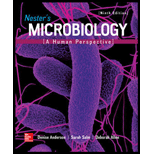
Concept explainers
Why are restriction enzymes useful in
To review:
The importance of restriction enzymes in the biotechnology.
Introduction:
In biotechnology laboratories, restriction enzymes or restriction endonucleases are utilized in order to cleave the double-stranded DNA (deoxyribonucleic acid) molecule into much simpler and smaller segments. These enzymes carry the capability to recognize the sites present on the duplex DNA and cleave at different sites on the DNA giving rise to smaller sequences.
Explanation of Solution
The ability to reproducibly cut the DNA at certain sequences by the restriction enzymes has led to the widespread use of the tool in the biotechnology, specifically molecular genetics lab. These enzymes can be utilized to map the fragments thatwill be obtained, and mapping helps in determining the order of these sites in the genome where the enzyme cleaved the DNA. Maps may also form the foundation for other genetic analysis and can also be used to identify the specific DNA segment, which depends on the known restriction enzyme sites.
Perhaps, the most vital role of these enzymes is the generation of the recombination molecules of the DNA that comprises the DNA fragments and genes from two organisms that are different. These enzymes can be used at different points in the process of recombination. They can be used to digest the DNA from the organism, which is under the experiment and this helps in preparing the DNA for the cloning process.
Second importance can be the cleaving of the DNA strands when restriction enzymes make a cleavage; two types of ends are produced namely sticky and blunt ends. These ends can then be ligated by the help of an enzyme known as DNA ligase.
It can also be used in identifying the strains of the individuals or some other species by pulsing the field of gel electrophoresis, which is basically a technique that is used to separate the huge fragments of the DNA. These fragments can be derived from digesting the genome of a bacterial strain with the help of a rare cutting restriction enzyme. These enzymes can also use in the restriction fragment length polymorphism analysis, which has been used widely for the identification process of the individuals.
In this, the genomic DNA is first isolated then digested by the enzymes and segregated on the basis of their size on an agarose gel and finally is transferred to a membrane. The DNA that is digested is allowed to bind to the fluorescentlylabeled probe, which targets the certain sequences, which are protected or bracketed by the sites of the restriction enzyme. The size of the segments cleaved will vary from one individual to another and this creates a biological barcode or a pattern which is unique to every individual.
Therefore, it can be concluded that these enzymes play an integral role in the biotechnology, specifically molecular and genetics laboratories.
Want to see more full solutions like this?
Chapter 9 Solutions
Nester's Microbiology: A Human Perspective
- What are the ethical concerns of using stem cells? CRISPR?arrow_forwardExplain the purpose of the antibiotic resistance gene in this experiment. Why is this genetic trait an important part of the recombinant DNA technology process in the biotechnology industry?arrow_forwardWhat is the importance of nanomedicine in biotechnology?arrow_forward
- Restriction enzymes and DNA ligase play essential roles in DNA cloning. How is it that a bacterium that produces a restriction enzyme does not cut its own DNA? Describe some general features of restriction sites.arrow_forwardRestriction enzymes and DNA ligase play essential roles in DNA cloning. How is it that a bacterium that produces a restriction enzyme does not cut its own DNA?arrow_forwardWhat is the difference between biotechnology and recombinant DNA technology?arrow_forward
- Why is using genomic DNA in gene therapy more efficacious?arrow_forwardb) Describe how DNA is digested by different restriction enzymes c) Describe how gel electrophoresis is used to estimate the size of DNA fragments.arrow_forwardWhat normal role do restriction enzymes play in bacteria? How do bacteria protect their own DNA from the action of restriction enzymes?arrow_forward
 Human Anatomy & Physiology (11th Edition)BiologyISBN:9780134580999Author:Elaine N. Marieb, Katja N. HoehnPublisher:PEARSON
Human Anatomy & Physiology (11th Edition)BiologyISBN:9780134580999Author:Elaine N. Marieb, Katja N. HoehnPublisher:PEARSON Biology 2eBiologyISBN:9781947172517Author:Matthew Douglas, Jung Choi, Mary Ann ClarkPublisher:OpenStax
Biology 2eBiologyISBN:9781947172517Author:Matthew Douglas, Jung Choi, Mary Ann ClarkPublisher:OpenStax Anatomy & PhysiologyBiologyISBN:9781259398629Author:McKinley, Michael P., O'loughlin, Valerie Dean, Bidle, Theresa StouterPublisher:Mcgraw Hill Education,
Anatomy & PhysiologyBiologyISBN:9781259398629Author:McKinley, Michael P., O'loughlin, Valerie Dean, Bidle, Theresa StouterPublisher:Mcgraw Hill Education, Molecular Biology of the Cell (Sixth Edition)BiologyISBN:9780815344322Author:Bruce Alberts, Alexander D. Johnson, Julian Lewis, David Morgan, Martin Raff, Keith Roberts, Peter WalterPublisher:W. W. Norton & Company
Molecular Biology of the Cell (Sixth Edition)BiologyISBN:9780815344322Author:Bruce Alberts, Alexander D. Johnson, Julian Lewis, David Morgan, Martin Raff, Keith Roberts, Peter WalterPublisher:W. W. Norton & Company Laboratory Manual For Human Anatomy & PhysiologyBiologyISBN:9781260159363Author:Martin, Terry R., Prentice-craver, CynthiaPublisher:McGraw-Hill Publishing Co.
Laboratory Manual For Human Anatomy & PhysiologyBiologyISBN:9781260159363Author:Martin, Terry R., Prentice-craver, CynthiaPublisher:McGraw-Hill Publishing Co. Inquiry Into Life (16th Edition)BiologyISBN:9781260231700Author:Sylvia S. Mader, Michael WindelspechtPublisher:McGraw Hill Education
Inquiry Into Life (16th Edition)BiologyISBN:9781260231700Author:Sylvia S. Mader, Michael WindelspechtPublisher:McGraw Hill Education





